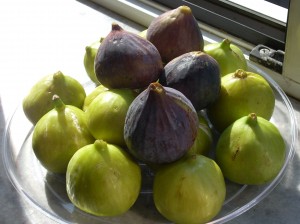I started to write a little bit about the things that I’ve missed in Armenia since leaving last year, but it quickly ceased to be “a little bit,” and so instead, I’ll talk about one of the most important things I’ve missed: the fresh fruit and vegetables. I love my neighborhood produce store in Chicago, don’t get me wrong, but the summer produce here is incredible: peaches as big as softballs and as sweet as honey, watermelon that melts in your mouth, juicy figs that don’t cost an arm or a leg (maybe an ankle, but they’re worth it), and the tomatoes. Oh, the tomatoes. Juicy, bright red, tender, flavorful—not picked green and then sent to a warehouse. All summer, before arriving here in August, I would look at even the organic tomatoes at my store in Chicago and sigh, reminding myself that true vine-ripened tomatoes were waiting for me in Armenia.
Armenia’s fruit- and vegetable-basket is the Ararat plain, a mountainous plateau that has been at the heart of Armenia since time immemorial. Armenia has a number of inactive volcanoes and calderas in and around it, and it seems that the volcanic soil has a near-magical ability to grow a wide (and delicious) variety of fruits and vegetables. One of the traditional dishes here is khorovats, or barbecue, where pieces of meat are placed on skewers and cooked over coals. The meat is accompanied by whole peppers (spicy or not), eggplants, and tomatoes, all of which are also skewered and barbecued. There might be a variety of side dishes as well—sauteed eggplant slices with garlic and walnuts, fresh herbs, homemade yogurt and cheese, potatoes, mushrooms, a million kinds of salads—but the simple preparation of the barbecued vegetables is mouthwateringly fantastic, with its combination of the charred exterior and the tender, juicy inside. I don’t eat meat, but I’ve never left a khorovats dinner without being stuffed.
When I first stayed in Yerevan in 2008 (before that, I had only lived in a smaller town called Aparan), even the large supermarkets had mostly seasonal produce. That meant that in the winter, there’d be primarily squashes and root vegetables, but it also meant that everything was fresh and not designed for optimal transportation. Now, you can find quinces from Moscow, lemons from Georgia, and, to my surprise (and error) last week, apples from New Zealand. I meant to buy some tasty local apples for my husband, but clearly, I should have been suspicious when I saw stickers on the fruit. The last New Zealand apple is still on our table, while we’ve eaten our way through peaches, figs, and local apples.
There are many traditional dishes available in Armenia, but my tastes are quite simple and tend to revolve around the fresh, delicious produce. I also find that I’m spoiled and rarely even buy some of these fruits and vegetables back in Chicago, preferring to avoid the mediocre and wait for the fantastic, when I come back to Armenia. I’m lucky that I get to come back frequently; scurvy isn’t fun, from what I hear.



Mmmmm -totally mouthwatering!